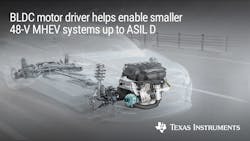New TI Motor Driver IC Gives Efficiency Boost to Hybrid Vehicles
This ElectronicDesign article is reprinted here with permission.
Texas Instruments introduced a new brushless DC (BLDC) motor driver for 48 V systems ranging from traction inverters to starter generators to bring more energy efficiency to hybrid electric vehicles (HEVs).
Texas Instruments said the chip can reduce the footprint of the systems surrounding electric motors in cars by up to 30% and supply what it called the highest gate-drive current for increased protection and power output. The DRV3255-Q1 is functionally safe and can supply up to 30 kW of power to the electric motor, which can reduce the latency of 48 V power delivery systems in trucks and other heavy vehicles.
With the era of electric vehicles looming, auto manufacturers are building more power efficient electrical and electronics (E/E) architectures in cars. The lithium-ion battery cells in fully electric vehices (EVs) have to distribute thousands of watts at the push of a pedal. To supply all the necessary power, manufacturers plans to roll out long-distance electric vehicles with 400 V to 800 V systems inside. And they are also supplementing legacy 12 V systems in cars to design hybrid electric vehicles (HEVs) with new 48 V rails.
To curb emissions, auto manufacturers are rolling out a class of so-called "mild" hybrid vehicles, which use electric motors and small batteries backed by 48 V systems to run the internal combusion engine more efficiently. That also saves fuel, including the range of the vehicle thousands of dollars to its total cost. The higher voltage of the 48 V system also supports higher currents, and thus, faster power delivery.
These types of vehicles shutdown the engine at a complete stop and use regenerative braking to recharge the battery pack, which is used to supply power to the 48 V electric motor that restart the engine and runs additional loads, like the power steering system. "Full" hybrid vehicles add on another feature: electric-only driving. The 48 V system can boost fuel economy of a traditional vehicle up to 20%, analysts estimate.
Texas Instruments said its new chip is the first three-phase BLDC motor driver on the market to integrate high- and low ide active short-circuit logic in a single chip for 48 V systems. This effectively eliminates the need for external transistors or control logic used to run the three-phase induction motors in electric cars. This type of electric motors use three alternating current (AC) power sources that are intentionally out of phase with each other. The continuously rotating magnetic field that results spins the motor in the HEV.
By integrating more system protections and other safety features, the chip enables customers to simplify 48-V systems in the vehicle, saving precious space on the PCB and reducing bill of materials (BOM) costs, the company said. The chip's place in the system in between the battery and the MOSFETs that are used to rotate the motor. Texas Instruments said the DRV3255-Q1 can supply up to 30 kW of power output.
"A 48 V system is a step-change that original equipment manufacturers (OEMs) can implement to meet goals around reducing emissions while also adding power for advanced driver-assistance system features and managing power-hungry loads such as the heating, ventilation, and air conditioning system," said Asif Anwar, analyst for the powertrain, body, chassis, and safety service at Strategy Analytics, in a statement.
Texas Instruments said it has higher power output levels than other chips on the market, reducing latency in 48 V systems. That gives trucks and other heavy vehicles the ability to accelerate faster from a full stop.
The chip is specifically designed to drive electric motors requiring up to 600 A of current by supplying 3.5 A peak "source" and 4.5 A peak "sink" currents. It can also withstand transient overvoltage conditions up to 90 V. Texas Instruments said the bootstrap architecture of the chip cuts power losses and self-heating of the internal gate drivers. The charge pump integrated in the IC supports 100% PWM duty cycle control.
The chip also has resistance to voltage spikes and other fault conditions in electric vehicles to protect it against permanent damage. It can tolerate temperatures in a range of -40° to 150°C, the company said.
Texas Instruments said the new IC was subject to its functional safety development process. The chip integrates advanced safety features, internal failure modes, and system diagnostics to prevent faults before they become widespread failures. With its onboard safety features and failsafes, it meets the requirements of ASIL-D, the most advanced functional safety level for cars in the ISO 26262 standard.
The active short-circuit feature also gives customers the flexibility to integrate MOSFETs based on the system's requirements. The device's fault response feature is used to automatically engage the active short-circuit mode in overvoltage conditions to prevent system failures. This helps protect the electric motor and electrical components from dangers at high voltages while boosting system performance.
The company said the chip is also designed to defend against voltage spikes and other transients up to 95 V and load-dump conditions on 48 V rails, effectively eliminating the use of other components to protect it.
About the Author
James Morra
Senior Editor
James Morra is the senior editor for Electronic Design, covering the semiconductor industry and new technology trends, with a focus on power electronics and power management. He also reports on the business behind electrical engineering, including the electronics supply chain. He joined Electronic Design in 2015 and is based in Chicago, Illinois.

